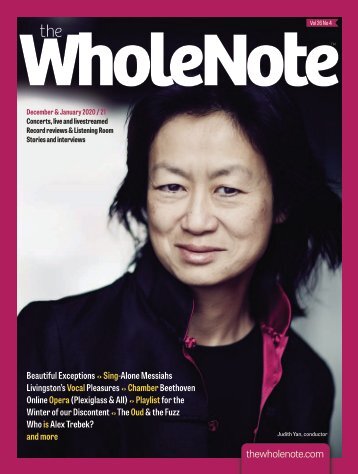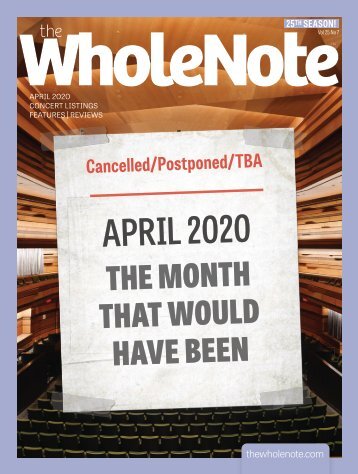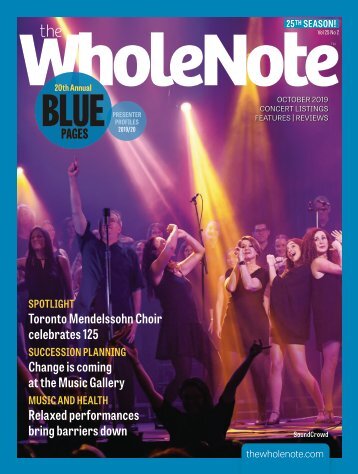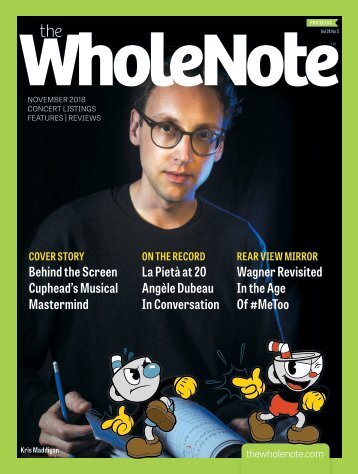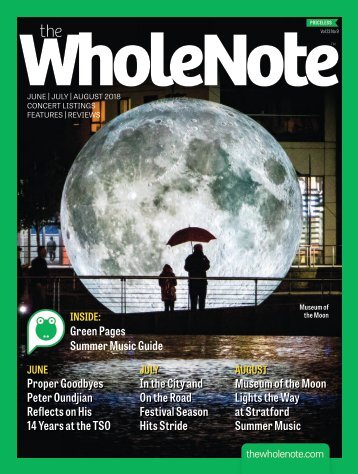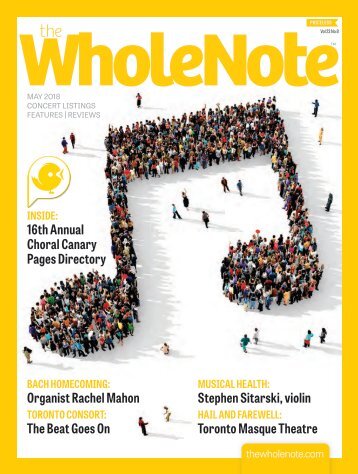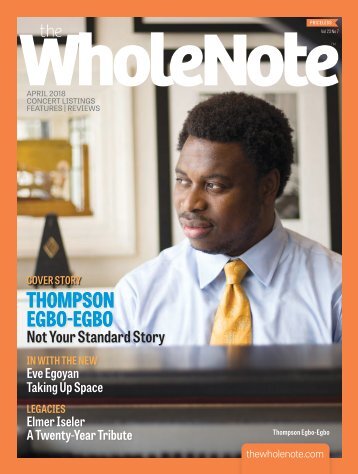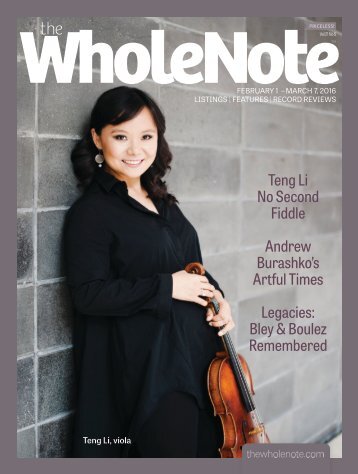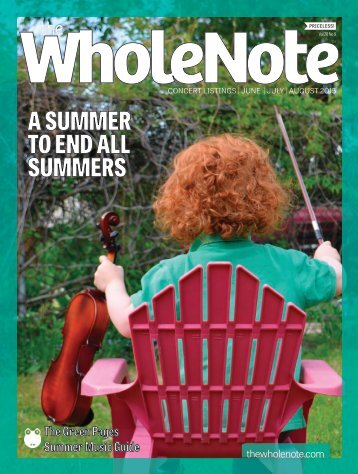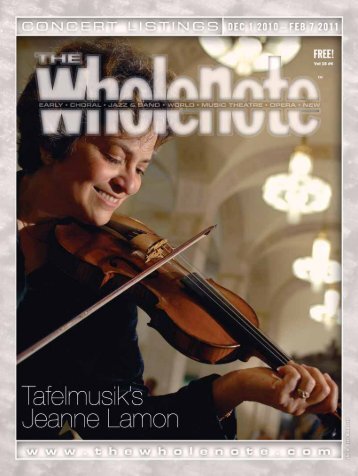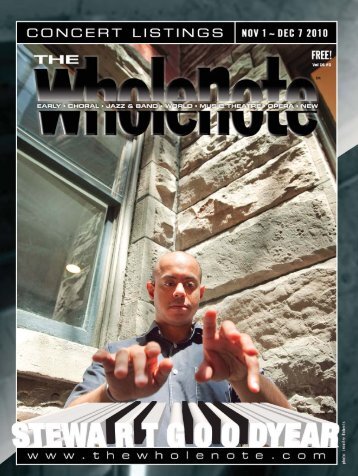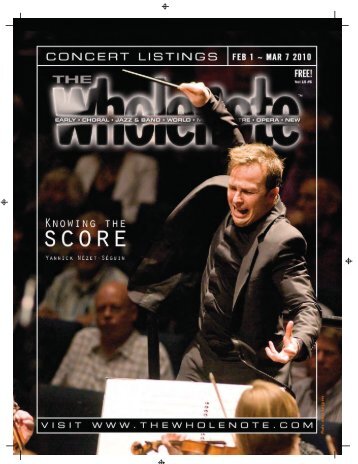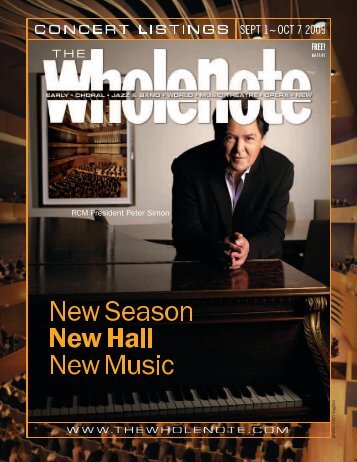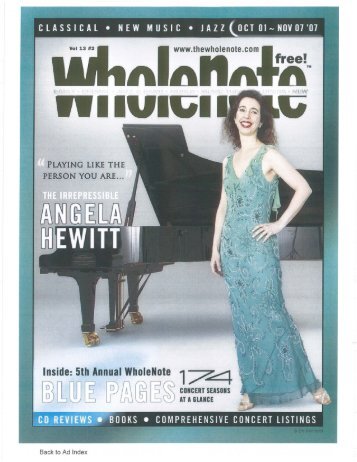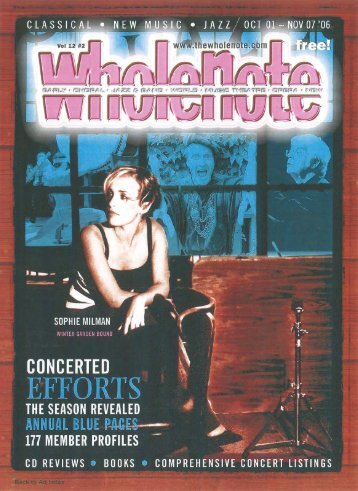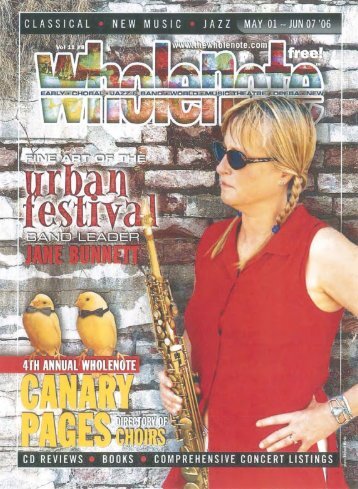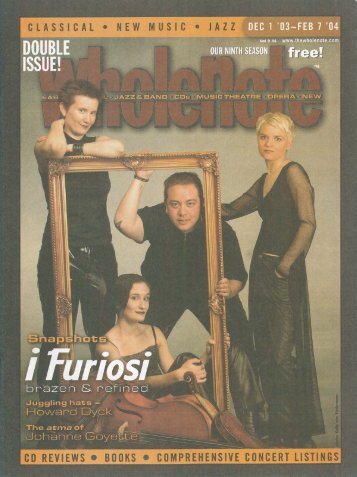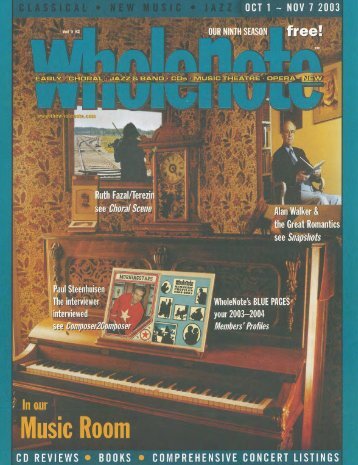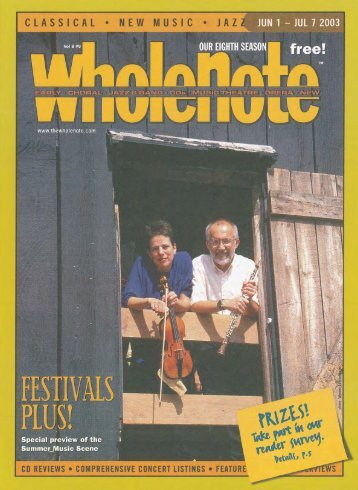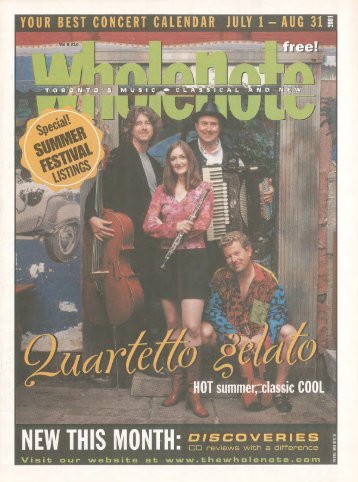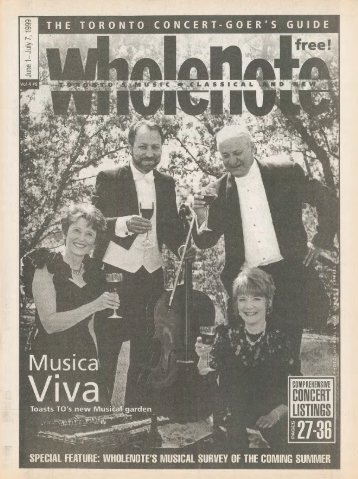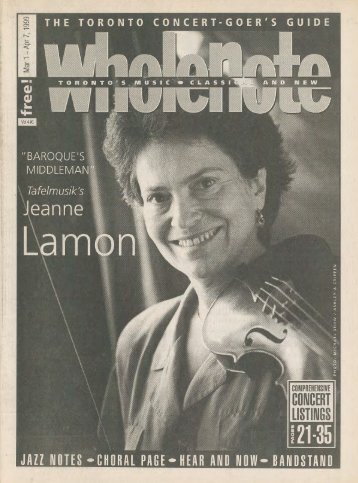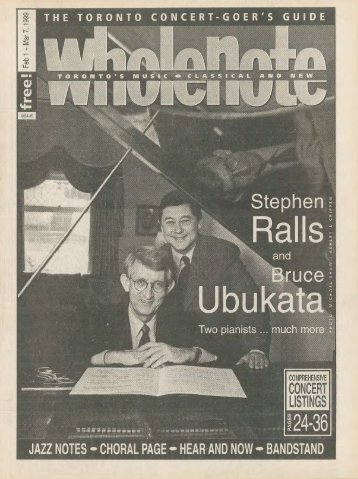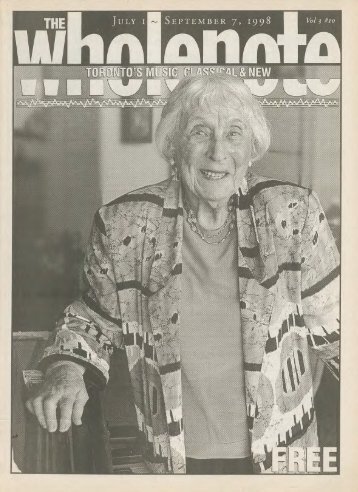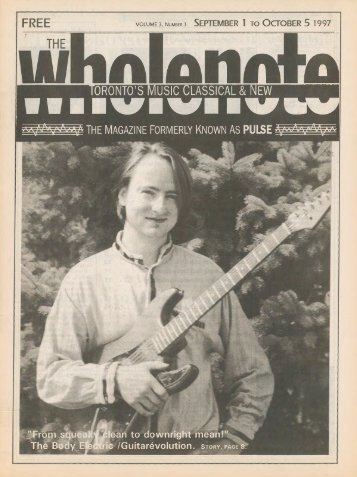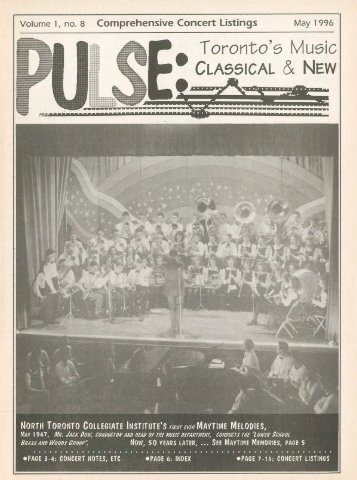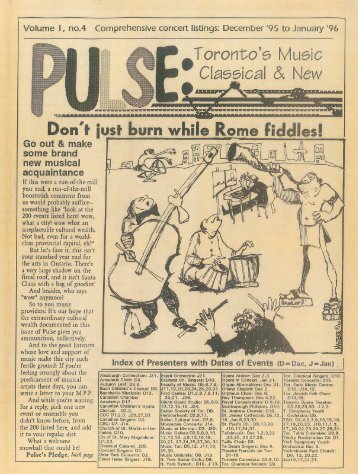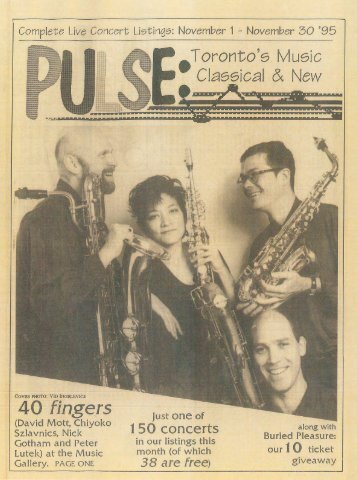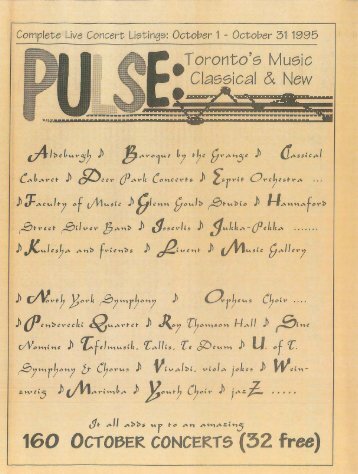Volume 20 Issue 7 - April 2015
- Text
- April
- Toronto
- Jazz
- Theatre
- Arts
- Musical
- Bloor
- Symphony
- Trio
- Orchestra
So far, it seems to be
So far, it seems to be working.Now in its fourth year, the companyhas been involved with numeroussummer music festivals and localvenues. Upcoming are collaborationswith the RCM’s 21C Festivalin late May and with a numberof presenters in Nova Scotia andOntario. For Koniuk, the types ofaudiences that the project attracts,and the feedback they provide, isa big part of what makes her thinkthat this approach to contemporaryopera is one with a viable future.“I’m really proud of the diversityof our audiences,” Koniuk says.“We attract members of the cyclingcommunity who have certainlynever seen contemporary opera, and Larissa Koniuk and Geoffrey Sirettmaybe have never even been to a liveclassical concert. We also attract younger people who are part of thelarger arts community and also longstanding opera fans who possiblyhave never given contemporary music a chance before.”For Koniuk, helping those audiences give opera a chance is a centralpillar of the company’s work. By challenging those common misconceptionsabout the necessary grandeur of opera, Koniuk hopes to openup listeners to what the genre has to offer.“I think that we challenge the notion of who an opera singer is,”she says. “We show people that opera singers aren’t this elite group ofpeople who are inaccessible, singing in a language that people don’tunderstand. Rather, we’re regular folks who like getting on our bikesand powering ourselves from one venue to the next. We get dirty, weknow how to change a flat tire, we get splashed in the mud, we getcaught in the rain—and we go to sleep and wake up the next day, puton our costumes and put on a great show.”The Bicycle Opera Project will perform a number of contemporaryopera scenes on May 21, as part of the RCM’s 21C Festival (which runsMay 20 to 24 this year). Keep an eye out for the details of their 2015tour, which will include venues in Eastern Canada as well as a numberof dates in southern Ontario this summer.So, what is the takeaway from these stories, and those of other localcompanies that are working to realize a new vision of opera as a genrein renewal?For one thing, it shows that opera can be many things—grand,intimate, comforting, shocking, and that grand doesn’t necessarilymean the same as big. For another thing, that opera can also be formany different kinds of people and be offered to audiences in manydifferent forms. And that the story of how opera continually remakesitself for the times is as moving and inspiring as the stories opera tells.Misconceptions about what the opera experience can and cannot beare beginning to loosen their grip. The stories that opera tells are timeless;and these new storytellers are more than ready to take them tofresh ears and eyes.Sara Constant is The WholeNote’s social media editor. Shecan be contacted at editorial@thewholenote.com.Great Artist MusicSeries presentsJue Wang,pianoFriday, May 18pmauroraculturalcentre.ca905 713-1818Beat by Beat | Classical & BeyondWater in theMusicPAUL ENNIS“Grimaud doesn’t sound like most pianists. She is a rubato artist, areinventor of phrasings, a taker of chances.”— D.T. Max, The New Yorker, 2011The remarkable French-born pianist Hélène Grimaud last visitedToronto a year ago when she performed Brahms’ Piano ConcertoNo.1 with the TSO and showed off her great dynamic range. Herintimate pianism exposed the intrinsic beauty of the slow movementand she entered fully into the passion of the third movement with itsrhapsodic cadenza, spurring the audience into an immediate standingovation. The year before she held the Koerner Hall audience in hersway with a performance of her Resonances CD that moved fromMozart to Berg to Liszt to Bartók, all united by the historical fact of thecomposers being children of the Austro-Hungarian Empire.Her upcoming Koerner Hall appearance April 19 is typical of heradventurous spirit and imaginative programming. All the pieces areunited by the theme of water: Berio’s Wasserklavier III; Takemitsu’sRain Tree Sketch II; Fauré’s Barcarolle No.5 in F-sharp Minor, Op.66;Ravel’s Jeux d’eau; Albéniz’s Almería from Iberia Suite Book 2; Liszt’sLes jeux d’eaux à la Villa d’Este from Années de pèlerinage: Troisièmeannée, Janáček’s In the Mists I; Debussy’s La Cathédrale engloutieHélène Grimaud with conductor Yannick Nézet-Séguin in San Francisco atthe end of their recent tour with the Rotterdam Symphony Orchestra.CelebratingBrahmsJOYCE LAI, violin; RACHEL MERCER, celloTAK NG LAI, conductorDouble Concerto for Violin and CelloSymphony No. 1Saturday May 9, 8PM,Glenn Gould Studio, 250 Front St.W. Adult Senior $20 StudentCall: TICKET BREAK 1-866-943-8849canadiansinfonietta.com10 | April 1 - May 7, 2015 thewholenote.comMAT HENNEK
SASHA GUSOVfrom Préludes, Book I; concluding withBrahms’ Piano Sonata No.2 in F-sharpMinor, Op.2.She told William Grimes of The NewYork Times: “Water is the element mostnecessary to life, the most preciousresource for our planet, the mostendangered and the one that posesthe greatest risk on its potential forconflict.” Explaining her process ina video for the artnet News website,she described how she spent twoyears “boiling down” her conceptionof pieces having to do with water, toEvgeny Kissin reduce it to “something very pure andabstract in its expression.” There wereseveral Liszt works that fit her original idea but the one she finallyselected was the “most abstract of all his water pieces.”“An art form has to live in the moment,” she said. “It has to sound asif it is being written while you hear it.” On the San Francisco ClassicalVoice website she explained to Lara Downes earlier this year that thewater program is “more fragile and vulnerable repertoire, and as anaudience member you have to be willing to make that journey.”When she performed the same pieces last December in New Yorkover ten nights, she did so in an inch of water, mixing performance artmetaphors. Anthony Thommasini in The New York Times describedthe riveting 20-minute process of filling the 55,000 square foot DrillHall of the Park Avenue Armory with that inch of water for “TearsBecome ... Streams Become ... ” He called the collaboration betweenGrimaud and the artist Douglas Gordon a “compelling, boldly originalwork, a dramatic combination of art installation, light show andpiano recital.”Brian Levine, the executive director of the Glenn Gould Foundation,sees in Grimaud a resemblance to Gould: “She has this willingness totake a piece of music apart and free herself from the general body ofpractice that has grown up around it.”Ten days after her Toronto concert she performs with the StamfordSymphony Orchestra to bring awareness to her other passion:environmental education centred around wolves – she founded theWolf Conservation Center in South Salem, New York in 1996.Evgeny Kissin: Evgeny Kissin’s mother was a piano teacher, hisfather an engineer. When Kissin was born (in Moscow in 1971), hissister, who was more than ten years older, was learning the piano. InChristopher Nupen’s DVD Evgeny Kissin: The Gift of Music, Kissintells a tale one would be inclined to dismiss as apocryphal were it notfor everything that has happened to him since. He had been a quietbaby, even standing on his cot in silence as his sister practised. Whenhe was 11 months old, he opened his mouth and sang the Bach fugueshe had just been playing (the Prelude and Fugue in A-Major from the2nd book of the Well-Tempered Clavier). By the time he could reachthe keyboard he was two and on his way to superstardom.He elaborated in an interview with Frederic Gaussin for piano magon iplaythepiano.com. “Before I began my studies at the School, I hadbeen listening to music non-stop, practically from the day I was born.I became familiar very early on with all different kinds of music andpieces, until one day I became physically able to touch the keyboardand play this repertoire, these melodies, by ear ... From the verybeginning, my taste was vast, very eclectic.”In that interview he speaks of Chopin as the composer that he playsthe most, “whose music is closest to my heart.” He continues: “Froma pianistic point of view, Chopin was a revolutionary, the only one(with the exception of young Scriabin, who drew much from Chopin)who demands such flexibility from the hand at the piano.” Gaussinraises the topic of Debussy – not in Kissin’s repertoire – as someonewho was not “any less sensitive or technically innovative than Chopinin his personal idiom.” Kissin responds that the same is true ofShostakovich, Schoenberg and Prokofiev, adding Messiaen, “whoseworks I do not yet play. His music is profound, very spiritual. He’s athewholenote.com April 1 - May 7, 2015 | 11
- Page 1 and 2: PRICELESS!Vol 20 No 7CONCERT LISTIN
- Page 3 and 4: 2015 ~2016Subscription Series44thSe
- Page 5 and 6: Volume 20 No 7 | April 1 to May 7,
- Page 7 and 8: LOOK! LEARN!LISTEN!THE BLUE PAGESA
- Page 9: Gillian Grossman and JeremyLudwig,
- Page 13 and 14: BO HUANGwho tests the mettle of the
- Page 15 and 16: Rebanks FamilyFellowship ConcertTUE
- Page 17 and 18: match the movements of the dancers,
- Page 19 and 20: IRAKLIZari performing at the Capito
- Page 21 and 22: an unaccompaniedAisslinn Nosky Tele
- Page 23 and 24: CHOIR & ORGAN CONCERTSEMILY DINGSte
- Page 25 and 26: an Ontario government agencyun orga
- Page 27 and 28: BRUCE ZINGEROpera Atelier’s Orphe
- Page 29 and 30: will be journeys, travels and retur
- Page 31 and 32: American Brass Band Association (NA
- Page 33 and 34: Messiah (excerpts from part 2). Sac
- Page 35 and 36: ●●4:30: Beach United Church. Ca
- Page 37 and 38: Vespers: Jaymz Bee Birthday Vespers
- Page 39 and 40: Noble Jr.: Listen to the Angels Sho
- Page 41 and 42: century repertoire for violin and h
- Page 43 and 44: -;-(sr);-(35 and
- Page 45 and 46: Richard Margison, St. Michael’s C
- Page 47 and 48: Creation. Bach: Orchestral suite No
- Page 49 and 50: Hungarian Dance No.18; Violin Conce
- Page 51 and 52: of music education has led toan ove
- Page 53 and 54: E The ETCeterasHot Docs 2015PAUL EN
- Page 55 and 56: McGill. Location tba, 273 Bloor St.
- Page 57 and 58: Classified Advertising | classad@th
- Page 59 and 60: facilities are perfectly suited to
- Page 61 and 62:
information@summermusic.comwww.summ
- Page 63 and 64:
NEW CONTEST!Who is May’s Child?~
- Page 65 and 66:
DISCOVERIES | RECORDINGS REVIEWEDIw
- Page 67 and 68:
with the sense of ritual needed for
- Page 69 and 70:
if Sonata II is more restrained; th
- Page 71 and 72:
fares far better. It was filmed at
- Page 73 and 74:
greatest records, but if they were
- Page 75 and 76:
appended by the string players mask
- Page 77 and 78:
SEASON PRESENTING SPONSORSPRINGTIME
- Page 79 and 80:
spotlightsouthafricaA 3 WEEK FESTIV
Inappropriate
Loading...
Mail this publication
Loading...
Embed
Loading...
























